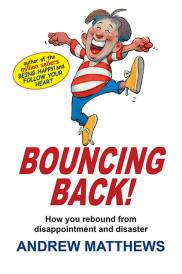Eric Brevig Journey to the Center of the Earth Interview
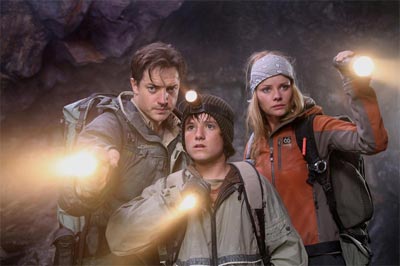
ERIC BREVIG HEADS TO THE CENTER OF THE EARTH.
EXCLUSIVE Interview by Paul Fischer.Special effects wizard Eric Brevig makes his feature film directorial debut of an ambitious and contemporary retelling of the classic Jules Verne classic Journey to the Center of the Earth which he shot in 3D. Brendan Fraser stars as a science professor whose radical theories have completely tarnished his reputation. While backpacking across Iceland with his nephew Sean, the two explorers find a cave that leads them deep down into the bowels of the planet. And so they go on a quest to find out what has happened to the scientist's missing brother, a scientist, his nephew and their mountain guide discovers a fantastic and dangerous lost world in the center of the earth. There they discover a bizarre landscape filled with terrifying creatures.
The first-time director talked exclusively to Paul Fischer.
Paul Fischer: Tell me about the genesis of this. Did you want to try to do an adaptation of the Verne story, or did you always intend to make it a little bit more - sort of expanded on the normal.
Eric Brevig: Well, the first thing I did was, I read the novel. And I said, "Holy shit. Nobody's going To be interested in a movie where they take six months to get to Iceland, and then they take three months to walk to the center of the earth." I go, "We've got to take some creative liberties." And so the first thing was - and Walden Media, who was developing it, was already kind of on board to update it. Because I felt by going period, once again, we were removing it from the accessibility to a modern audience. So we were all in agreement that it would be set in modern day. And the goal was to make it in the spirit of the original book, but kind of modernized for an audience that understands that it only takes twelve hours to get to Iceland these days, and that's not a big part of the adventure. And you can't really walk down to the center of the earth. So with that in mind, I revised the science to be what I call "barely possible." Maybe not probably, but barely possible. And we sort of rationalized all the cool things that we took from the book, such as prehistoric creatures and an underground ocean, and things of that nature, and just tried to make it a big, fun adventure where we actually referenced the original Jules Verne novel, rather than trying to make a movie of the novel.
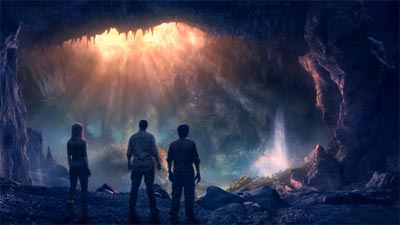 Paul Fischer: How concerned was Brendan when he signed up that this was not going to be another Mummy-type film, or Mummy-type character that he was being asked to play?
Paul Fischer: How concerned was Brendan when he signed up that this was not going to be another Mummy-type film, or Mummy-type character that he was being asked to play?Eric Brevig: Well, because I was in charge of the character, I wasn't too worried. I was more delighted - Brendan was my first choice, because I knew his artistic range as an actor. He's best known for The Mummy, but he's done a lot of brilliant serious work. And I knew that he was capable of, really, anything that I threw at him. And having looked at all his work, I knew which parts of things I'd seen before that I wanted to sort of embody in the character he was going to play. So I came to it with a specific goal. And then he sort of - to my delight - was much smarter than me. And said, you know, "Well, people don't like it when I play this. And this is what I think the character should do so this is motivated." And we were both exactly on the same mindset, right from the first day.
Paul Fischer: What about locations for this? What were you looking for, in terms of shooting locations? And what did you end up finding, that suited the script?
Eric Brevig: The locations? We only had one location. We were on a stage in Montreal, or in Montreal City, for everything except for the exteriors up in Iceland climbing the hill and talking and running. Everything else was done either on a set, on our sound stage, or in a local park in downtown Montreal. Any of the underground stuff was all done in the same four sound stages, being hastily struck and rebuilt in the different sets as we worked. We went to Iceland for a couple of days of exterior shooting, for the daytime stuff of them climbing up the mountains, and Brendan running, and the lightning storm and so forth. And then everything else was locations that we built in Montreal. Hannah's house and the Italian farm at the end are both in a public park in the middle of Montreal.
Paul Fischer: What other challenges did you face? What was your shooting schedule? It wasn't that long, was it?
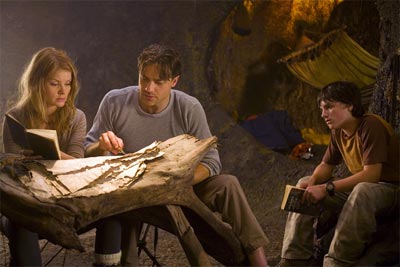 Eric Brevig: No, it was very brief for this kind of movie. It was 48 days.
Eric Brevig: No, it was very brief for this kind of movie. It was 48 days.Paul Fischer: So what kind of challenges did you have in putting together basically what is an action movie with this kind of complexity, in such a short time?
Eric Brevig: Yeah -- just trying to get it shot as fast as we could. We had 40 different sets to shoot, and we had less than 40 days on the stage. So we literally were running from sound stage to sound stage, and having to strategize - you know, what set fits in one place while the other one's being built? You can't be shooting on the same stage as the set's deconstructed, because they're noisy. The logistics of it were - you know, an amazing puzzle that we were solving until the last day.
Paul Fischer: These kinds of movies are very tough to market, really, because you're really trying to cater to both fans of Jules Verne, and contemporary audiences. What is the balancing act, that you have to get those two groups in to see the movie?
Eric Brevig: Well, you know, what I did was, I said, you know, "What is it that I'm trying to make here?" And as a kid, I would see these movies that were just captivating and magical, and I wanted to be in the movie, and I got caught up in it, watching it. And as an adult, with children of my own, I notice that there's a real scarcity of these movies that kids can go to, that aren't talking down to the adults. So my goal was to make a movie that was fun on both levels. If you're a kid, you just enjoy the ride. And the visceral fun of the movie. And if you're an adult, there's enough sort of smart stuff in there, that you get jokes and things that are aimed at you. There's enough sort of self-awareness of the movie that it's like, we're all having a good time together. But the adults enjoy it as much as the kids, but on a different level.
Paul Fischer: What about the 3-D aspect of this? You did shoot it in 3-D?
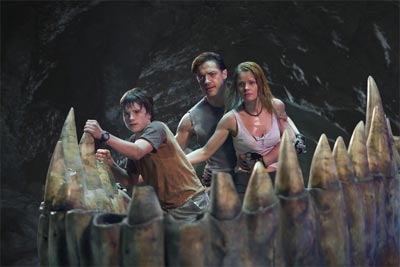 Eric Brevig: Absolutely. Absolutely. I was using brand new cameras that were built to my request, based on cameras that Jim Cameron had designed and built with his engineering partner, Vince Pace, for his underwater documentaries. And they were literally finished coming out of the machine shop the week before we started shooting. They were no bigger than a normal camera. All the electronics were connected via fiber-optic and kept off-set. And the actual recording of the images was done 400 feet away from where we were shooting. So I had them on steadicams, handheld, on cranes, underwater, on helicopters. One of my rules was, we're not going to make any restrictions to the filmmaking because we're using 3-D. Because I'm making a good movie that happens to be in 3-D. Not a 3-D movie.
Eric Brevig: Absolutely. Absolutely. I was using brand new cameras that were built to my request, based on cameras that Jim Cameron had designed and built with his engineering partner, Vince Pace, for his underwater documentaries. And they were literally finished coming out of the machine shop the week before we started shooting. They were no bigger than a normal camera. All the electronics were connected via fiber-optic and kept off-set. And the actual recording of the images was done 400 feet away from where we were shooting. So I had them on steadicams, handheld, on cranes, underwater, on helicopters. One of my rules was, we're not going to make any restrictions to the filmmaking because we're using 3-D. Because I'm making a good movie that happens to be in 3-D. Not a 3-D movie.Paul Fischer: How stressful was that for you, to be able to both - you had to be, really, a filmmaker, as well as working with these actors. What challenges were there in doing both of those things?
Eric Brevig: Well, the technical stuff is stuff that I've been doing for 20 years. So I did that up front, and then hired a crew of people. And I said, "I'm turning this over to you. Now I'm just going to be worried about storytelling, my actors, and how my characters are portrayed on the screen. You guys take care of the technical shit from now on." And they did. And I immersed myself in just worrying about characters and motivation and blocking, and all the issues that I knew my actors were going to be nervous about. And so what I did was, I talked to a lot of directors and producers that I knew, and one of them was George Lucas's producer. I said, "Well, how did you deal with the Star Wars movies, cuz you were using digital cameras. And tell me what tricks there are, and what pitfalls." And he said, "Make sure that you have, in the contract, two weeks of rehearsal time." And so I was certain to do that. And so literally two weeks before we started shooting, I met with my actors every day and we went through the entire movie scene by scene in a room with tape marks on the ground showing how big our working space was going to be on the set. And we just talked about dialogue and blocking, and, "Does this make sense?" And "I wouldn't say this." And "I feel like I want to do this." All the stuff that's important to the acting, which is important to the movie. Because it's the characters that the audience is watching. The characters are what engages the audience. The rest of the visual effects is just eye candy if you're not interested in what's going on. And so the three actors and myself basically worked through the movie before we got on the stage. And then when we got on the stage with the blue screens and the electronics and the cameras, we already knew what we were going to do. So that was the solution for that.
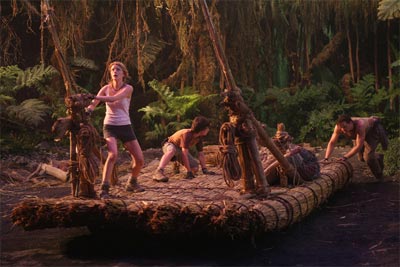 Paul Fischer: How did the New Line/Warner Brothers transition affect you?
Paul Fischer: How did the New Line/Warner Brothers transition affect you? Eric Brevig: Luckily, the movie was completely finished in February. So when Warner brothers took over, I had a few days of concern, when Jeff Robinov at Warner Brothers was going to screen the movie to see if they liked it or not. And luckily for me, they loved the movie. They doubled the marketing budget after they saw it, and it's been nothing but a real success story for the movie. While I was waiting to hear, "Does he love it or hate it?" I was very nervous.
Paul Fischer: Do you want to do something small next? Are you looking for trying to maybe do something a little bit less stressful?
Eric Brevig: Well, you know, actually, I like this kind of movie. I'd like it to be funded a little bit more fully. Because I spent a lot of time figuring out how to do things that looked like money on the screen, for no money. I actually did 40 composites, visual effects shots, on my laptop myself, because I didn't have the money. And I wanted the shots in the movie. So I'd like to do a fully-funded movie of this kind. For me, that would be less stressful.
Paul Fischer: What's next for you?
Eric Brevig: You know, I'm getting a lot of scripts sent to me, because producers are seeing the movie in advance. And I think it's going to be something along this line. A little bit more adult. Maybe PG-13, rather than PG. But I like the big adventure. I like using visual effects to tell the story. It's going to be something along that line.
Paul Fischer: Will you do a Journey sequel?
Eric Brevig: I would love to. If the movie is successful, I hope to get on that right away. Because I certainly like watching the three characters.
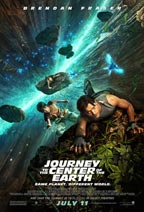
Journey to the Center of the Earth
Starring: Brendan Fraser, Josh Hutcherson, Anita BriemDirector: Eric Brevig
Screenwriter: Michael Weiss, Jennifer Flackett, Mark Levin
Producer: Charlotte Huggins, Beau Flynn
Composer: Andrew Lockington
Genre: Action/Adventure
Running time: 89 mins
An exciting adventure based on the classic Jules Verne novel 'Journey to the Center of the Earth', Journey to the Center of the Earth 3D stars Brendan Fraser (Crash, The Mummy) as a science professor whose untraditional hypotheses have made him the laughing stock of the academic community.... An exciting adventure based on the classic Jules Verne novel 'Journey to the Center of the Earth', Journey to the Center of the Earth 3D stars Brendan Fraser (Crash, The Mummy) as a science professor whose untraditional hypotheses have made him the laughing stock of the academic community.
But on an expedition in Iceland, he and his nephew stumble upon a major discovery that launches them on a thrilling journey deep beneath the Earths surface, where they travel through never-before-seen worlds and encounter a variety of unusual creatures. Journey to the Center of the Earth 3D is directed by Academy Award-winning visual effects veteran Eric Brevig (Total Recall, Pearl Harbor) from a screenplay by Michael Weiss and Jennifer Flackett & Mark Levin. The film is a co-venture between New Line Cinema and Walden Media. Journey to the Center of the Earth 3D is scheduled for a July 11, 2008 release
MORE
- Viggo Mortensen The Road
- 24 Cast Reunion
- Aaron Eckhardt No Reservations
- Aaron Eckhart The Dark Knight
- Adam McKay Step Brothers Interview
- Alan Alda Diminished Capacity Interview
- Alan Alda Diminished Capacity Interview
- Alex Dimitriades
- Al Pacino Oceans 13
- Alan Rickman Snow Cake
- Alan Rickman Sweeney Todd


